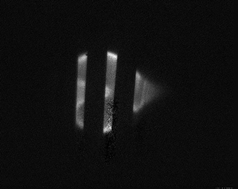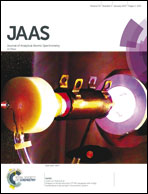Computational model of inductively coupled plasma sources in comparison to experimental data for different torch designs and plasma conditions. Part I: experimental study†
Abstract
Emission of argon, analyte atoms and ions, and OH lines in standard and low-argon-flow inductively coupled plasmas (ICPs) was studied spatially using a novel imaging acousto-optical spectrometer (AOS). Unique characteristics of the AOS (wavelength range: 250–800 nm, spectral resolution: 0.05–0.5 nm, time resolution: 5 ns, change of wavelength: 0.2 ms, spatial resolution: >125 μm) allowed the measurement of high quality images at 21 different wavelengths for each set of plasma conditions within approximately 20 min. Fundamental plasma properties were determined over a wide range of operational parameters. Rotational, excitation, and electron temperatures were ranging from 4580–5120 K, 4360–5000 K, and 8770–10 840 K in the analytical zone of the low-argon-flow ICP, and 3230–4250 K, 3000–5560 K, and 6130–10 200 K in the analytical zone of the standard ICP, respectively. The emission investigations were complemented by IR-measurements of the torch wall temperature and measurements of electrical properties of the ICP. RF voltages and RF currents were measured directly in the load coil and were used to calculate the plasma power. Depending on plasma conditions, the measured power differs from the indicated one (vendor software) by up to a factor of two.

- This article is part of the themed collection: 2016 Winter Conference on Plasma Spectrochemistry


 Please wait while we load your content...
Please wait while we load your content...